Unit 3 Professional Practice: Team Dynamics, CPD & Development Plan
VerifiedAdded on 2022/03/19
|23
|5341
|23
Report
AI Summary
This report delves into the significance of team dynamics in group work, highlighting the impact of team cognition, cohesiveness, and conflict on success. It details the author's experience within a team, outlining individual roles and contributions. Furthermore, the report explores the importance of Continuing Professional Development (CPD) and its role in personal learning and growth, providing examples and benefits of engaging in CPD activities. A comprehensive development plan is presented, encompassing responsibilities, performance objectives, and the skills, knowledge, and learning required for future professional advancement, including a self-assessment of strengths and weaknesses and a strategy for improvement. The document emphasizes the importance of continuous self-improvement and teamwork to achieve goals and improve professional performance.
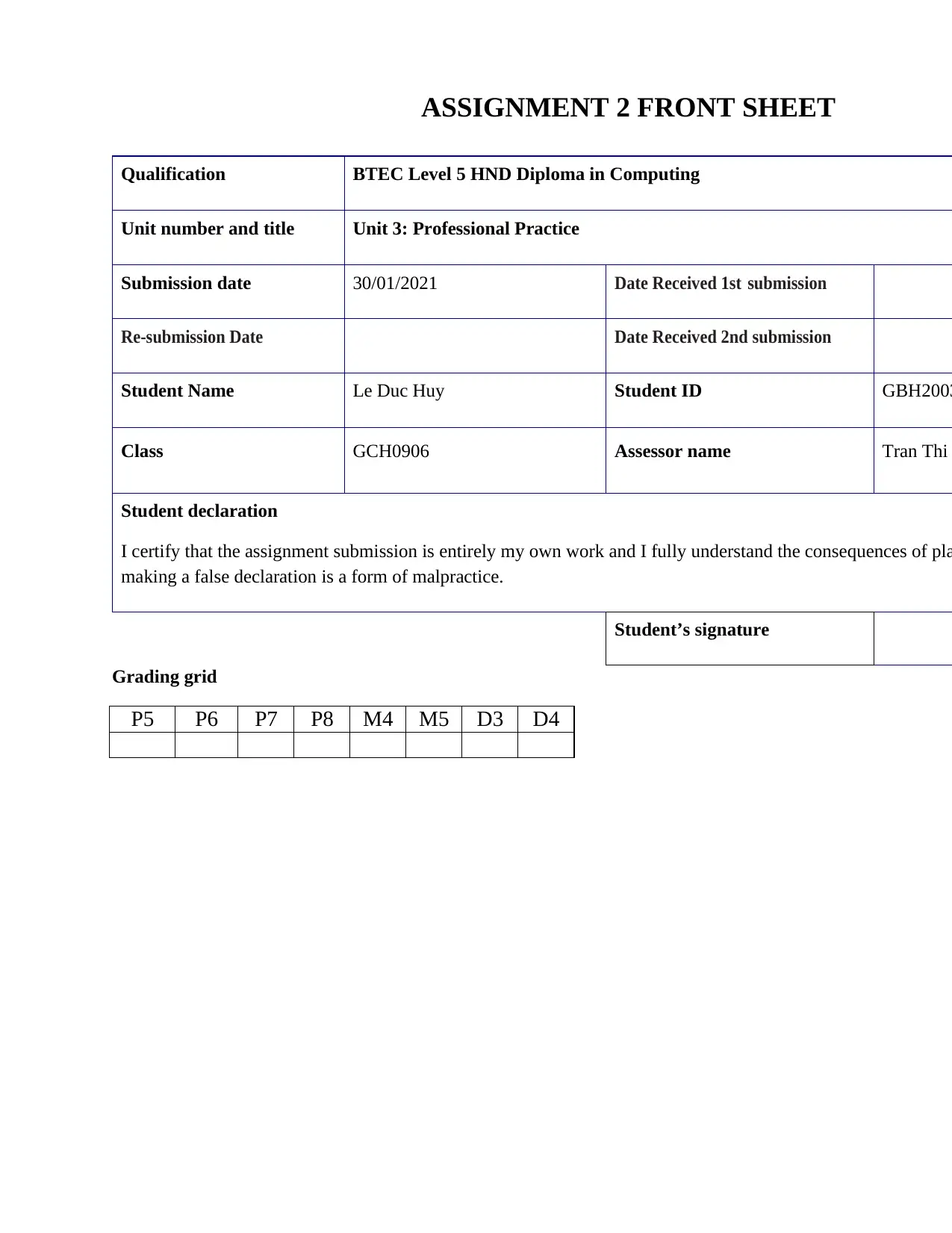
ASSIGNMENT 2 FRONT SHEET
Qualification BTEC Level 5 HND Diploma in Computing
Unit number and title Unit 3: Professional Practice
Submission date 30/01/2021 Date Received 1st submission
Re-submission Date Date Received 2nd submission
Student Name Le Duc Huy Student ID GBH2003
Class GCH0906 Assessor name Tran Thi
Student declaration
I certify that the assignment submission is entirely my own work and I fully understand the consequences of pla
making a false declaration is a form of malpractice.
Student’s signature
Grading grid
P5 P6 P7 P8 M4 M5 D3 D4
Qualification BTEC Level 5 HND Diploma in Computing
Unit number and title Unit 3: Professional Practice
Submission date 30/01/2021 Date Received 1st submission
Re-submission Date Date Received 2nd submission
Student Name Le Duc Huy Student ID GBH2003
Class GCH0906 Assessor name Tran Thi
Student declaration
I certify that the assignment submission is entirely my own work and I fully understand the consequences of pla
making a false declaration is a form of malpractice.
Student’s signature
Grading grid
P5 P6 P7 P8 M4 M5 D3 D4
Paraphrase This Document
Need a fresh take? Get an instant paraphrase of this document with our AI Paraphraser
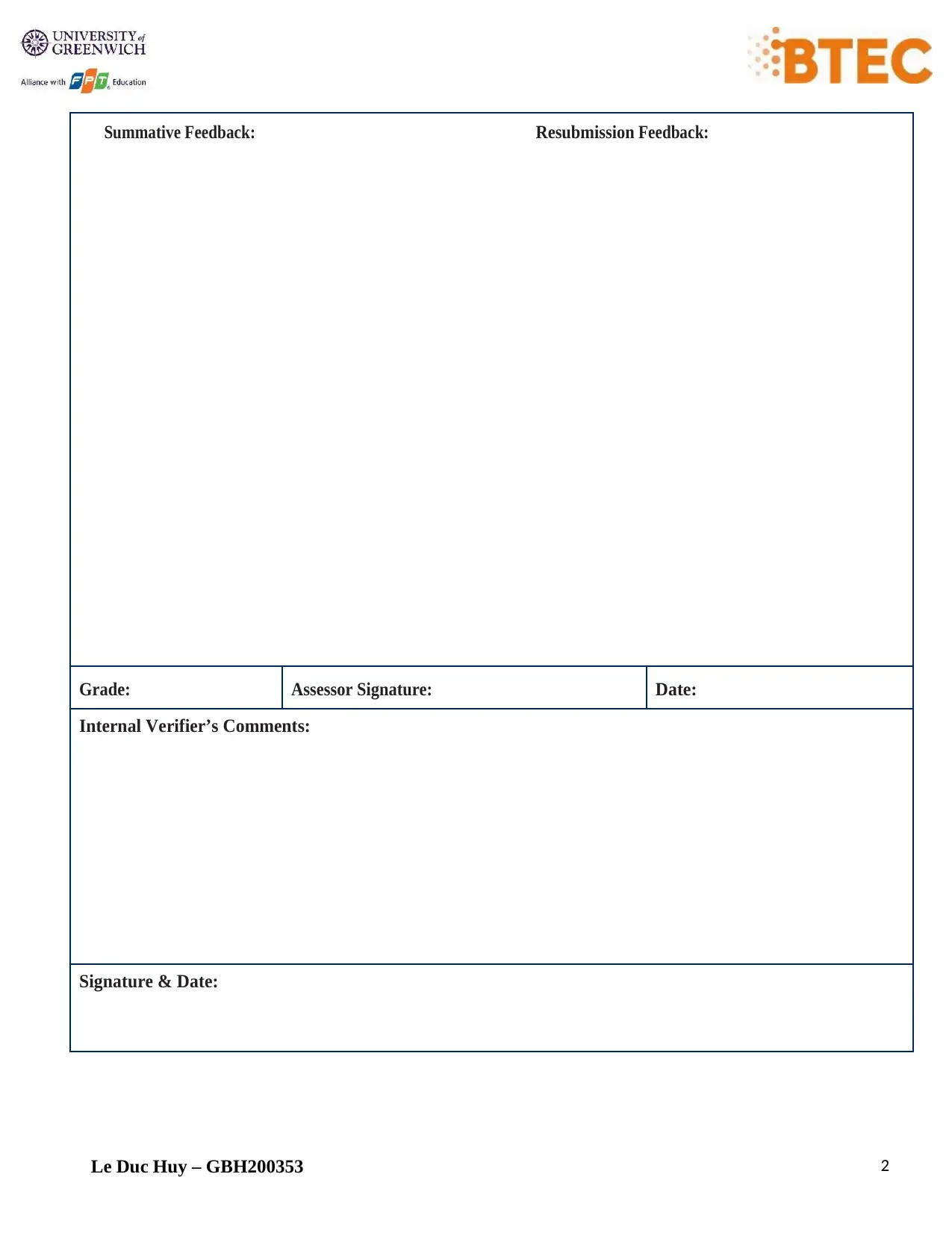
Le Duc Huy – GBH200353 2
Summative Feedback: Resubmission Feedback:
Grade: Assessor Signature: Date:
Internal Verifier’s Comments:
Signature & Date:
Summative Feedback: Resubmission Feedback:
Grade: Assessor Signature: Date:
Internal Verifier’s Comments:
Signature & Date:
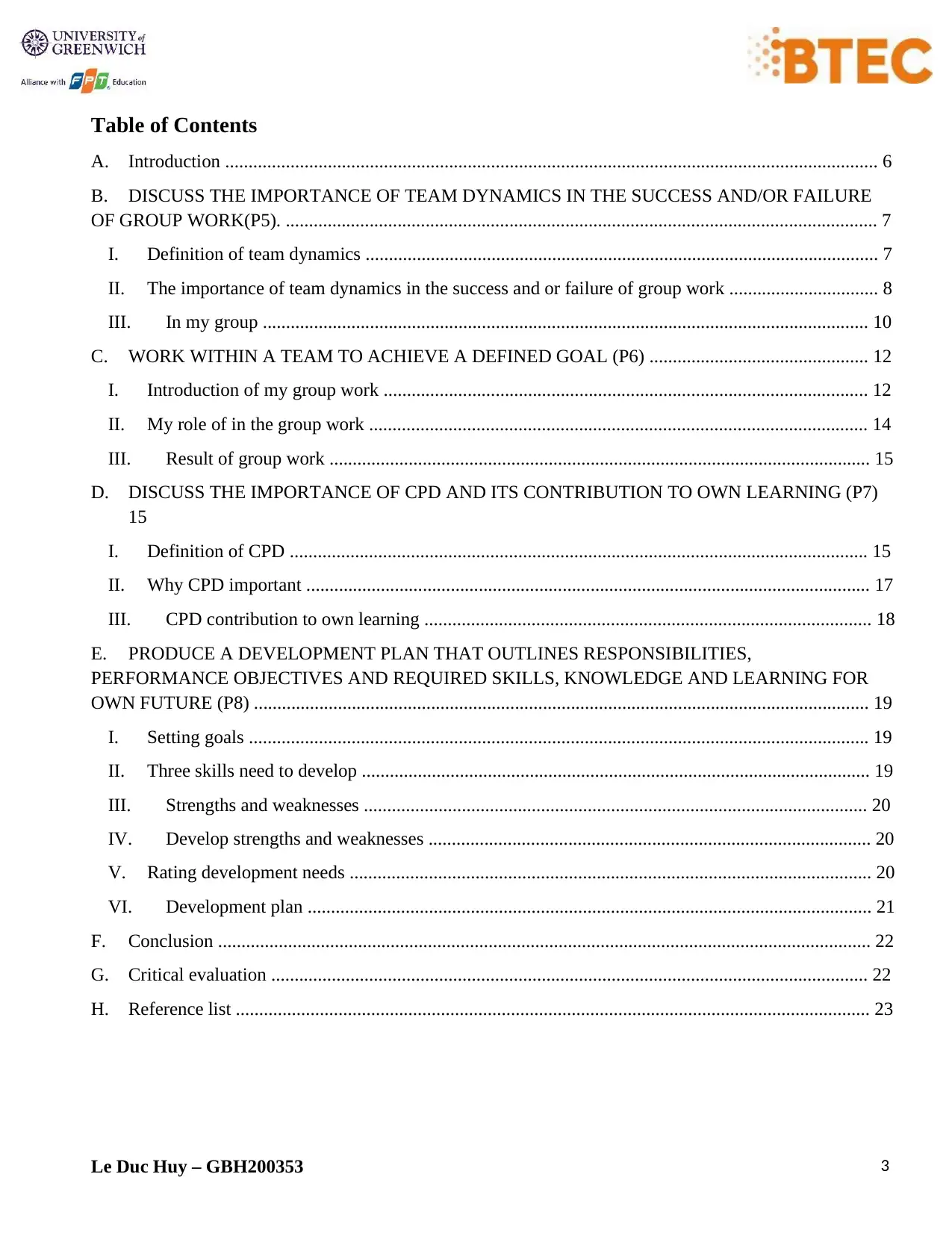
Le Duc Huy – GBH200353 3
Table of Contents
A. Introduction ............................................................................................................................................ 6
B. DISCUSS THE IMPORTANCE OF TEAM DYNAMICS IN THE SUCCESS AND/OR FAILURE
OF GROUP WORK(P5). ............................................................................................................................... 7
I. Definition of team dynamics .............................................................................................................. 7
II. The importance of team dynamics in the success and or failure of group work ................................ 8
III. In my group .................................................................................................................................. 10
C. WORK WITHIN A TEAM TO ACHIEVE A DEFINED GOAL (P6) ............................................... 12
I. Introduction of my group work ........................................................................................................ 12
II. My role of in the group work ........................................................................................................... 14
III. Result of group work .................................................................................................................... 15
D. DISCUSS THE IMPORTANCE OF CPD AND ITS CONTRIBUTION TO OWN LEARNING (P7)
15
I. Definition of CPD ............................................................................................................................ 15
II. Why CPD important ......................................................................................................................... 17
III. CPD contribution to own learning ................................................................................................ 18
E. PRODUCE A DEVELOPMENT PLAN THAT OUTLINES RESPONSIBILITIES,
PERFORMANCE OBJECTIVES AND REQUIRED SKILLS, KNOWLEDGE AND LEARNING FOR
OWN FUTURE (P8) .................................................................................................................................... 19
I. Setting goals ..................................................................................................................................... 19
II. Three skills need to develop ............................................................................................................. 19
III. Strengths and weaknesses ............................................................................................................ 20
IV. Develop strengths and weaknesses ............................................................................................... 20
V. Rating development needs ................................................................................................................ 20
VI. Development plan ......................................................................................................................... 21
F. Conclusion ............................................................................................................................................ 22
G. Critical evaluation ................................................................................................................................ 22
H. Reference list ........................................................................................................................................ 23
Table of Contents
A. Introduction ............................................................................................................................................ 6
B. DISCUSS THE IMPORTANCE OF TEAM DYNAMICS IN THE SUCCESS AND/OR FAILURE
OF GROUP WORK(P5). ............................................................................................................................... 7
I. Definition of team dynamics .............................................................................................................. 7
II. The importance of team dynamics in the success and or failure of group work ................................ 8
III. In my group .................................................................................................................................. 10
C. WORK WITHIN A TEAM TO ACHIEVE A DEFINED GOAL (P6) ............................................... 12
I. Introduction of my group work ........................................................................................................ 12
II. My role of in the group work ........................................................................................................... 14
III. Result of group work .................................................................................................................... 15
D. DISCUSS THE IMPORTANCE OF CPD AND ITS CONTRIBUTION TO OWN LEARNING (P7)
15
I. Definition of CPD ............................................................................................................................ 15
II. Why CPD important ......................................................................................................................... 17
III. CPD contribution to own learning ................................................................................................ 18
E. PRODUCE A DEVELOPMENT PLAN THAT OUTLINES RESPONSIBILITIES,
PERFORMANCE OBJECTIVES AND REQUIRED SKILLS, KNOWLEDGE AND LEARNING FOR
OWN FUTURE (P8) .................................................................................................................................... 19
I. Setting goals ..................................................................................................................................... 19
II. Three skills need to develop ............................................................................................................. 19
III. Strengths and weaknesses ............................................................................................................ 20
IV. Develop strengths and weaknesses ............................................................................................... 20
V. Rating development needs ................................................................................................................ 20
VI. Development plan ......................................................................................................................... 21
F. Conclusion ............................................................................................................................................ 22
G. Critical evaluation ................................................................................................................................ 22
H. Reference list ........................................................................................................................................ 23
⊘ This is a preview!⊘
Do you want full access?
Subscribe today to unlock all pages.

Trusted by 1+ million students worldwide
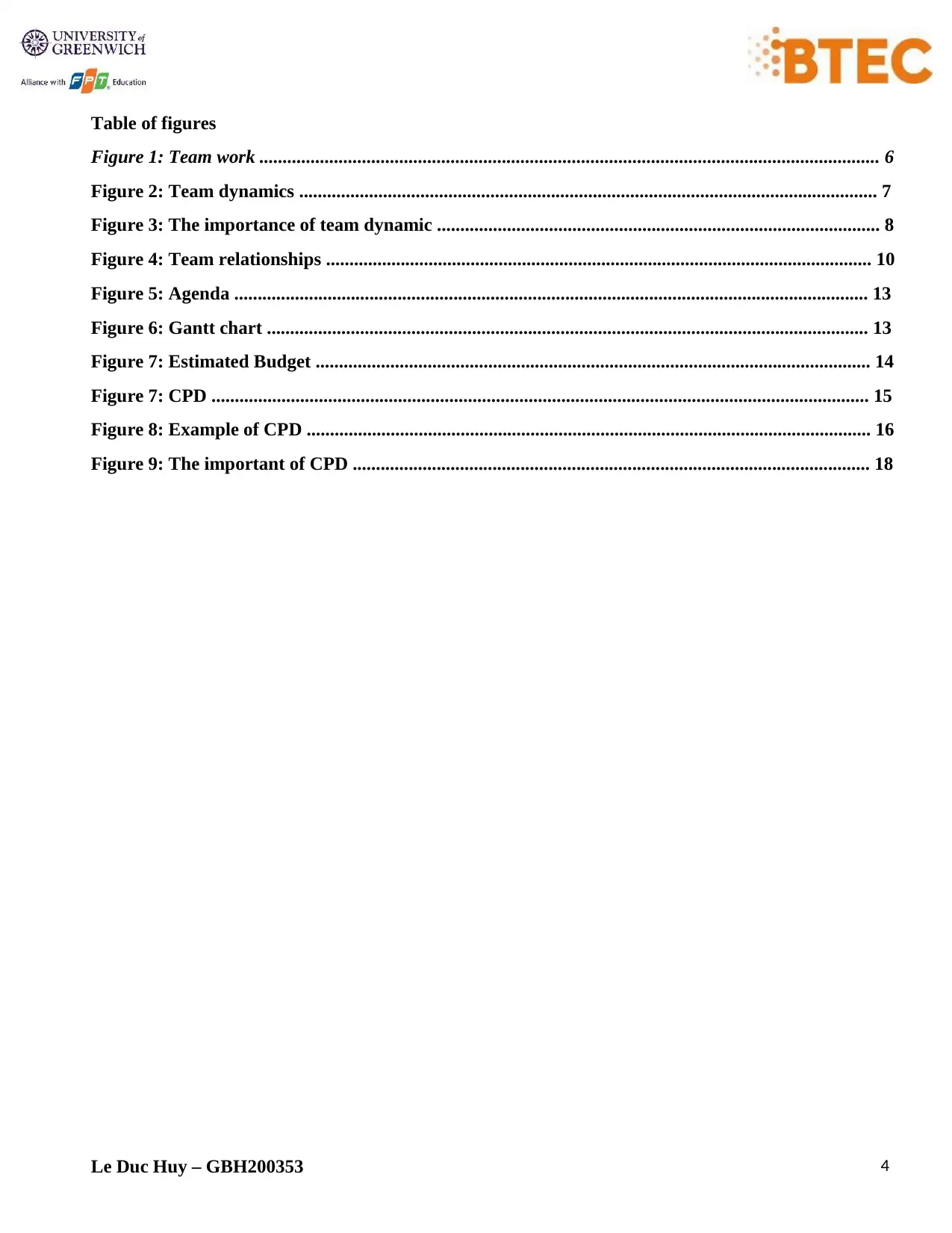
Le Duc Huy – GBH200353 4
Table of figures
Figure 1: Team work ..................................................................................................................................... 6
Figure 2: Team dynamics ............................................................................................................................ 7
Figure 3: The importance of team dynamic ............................................................................................... 8
Figure 4: Team relationships ..................................................................................................................... 10
Figure 5: Agenda ........................................................................................................................................ 13
Figure 6: Gantt chart ................................................................................................................................. 13
Figure 7: Estimated Budget ....................................................................................................................... 14
Figure 7: CPD ............................................................................................................................................. 15
Figure 8: Example of CPD ......................................................................................................................... 16
Figure 9: The important of CPD ............................................................................................................... 18
Table of figures
Figure 1: Team work ..................................................................................................................................... 6
Figure 2: Team dynamics ............................................................................................................................ 7
Figure 3: The importance of team dynamic ............................................................................................... 8
Figure 4: Team relationships ..................................................................................................................... 10
Figure 5: Agenda ........................................................................................................................................ 13
Figure 6: Gantt chart ................................................................................................................................. 13
Figure 7: Estimated Budget ....................................................................................................................... 14
Figure 7: CPD ............................................................................................................................................. 15
Figure 8: Example of CPD ......................................................................................................................... 16
Figure 9: The important of CPD ............................................................................................................... 18
Paraphrase This Document
Need a fresh take? Get an instant paraphrase of this document with our AI Paraphraser
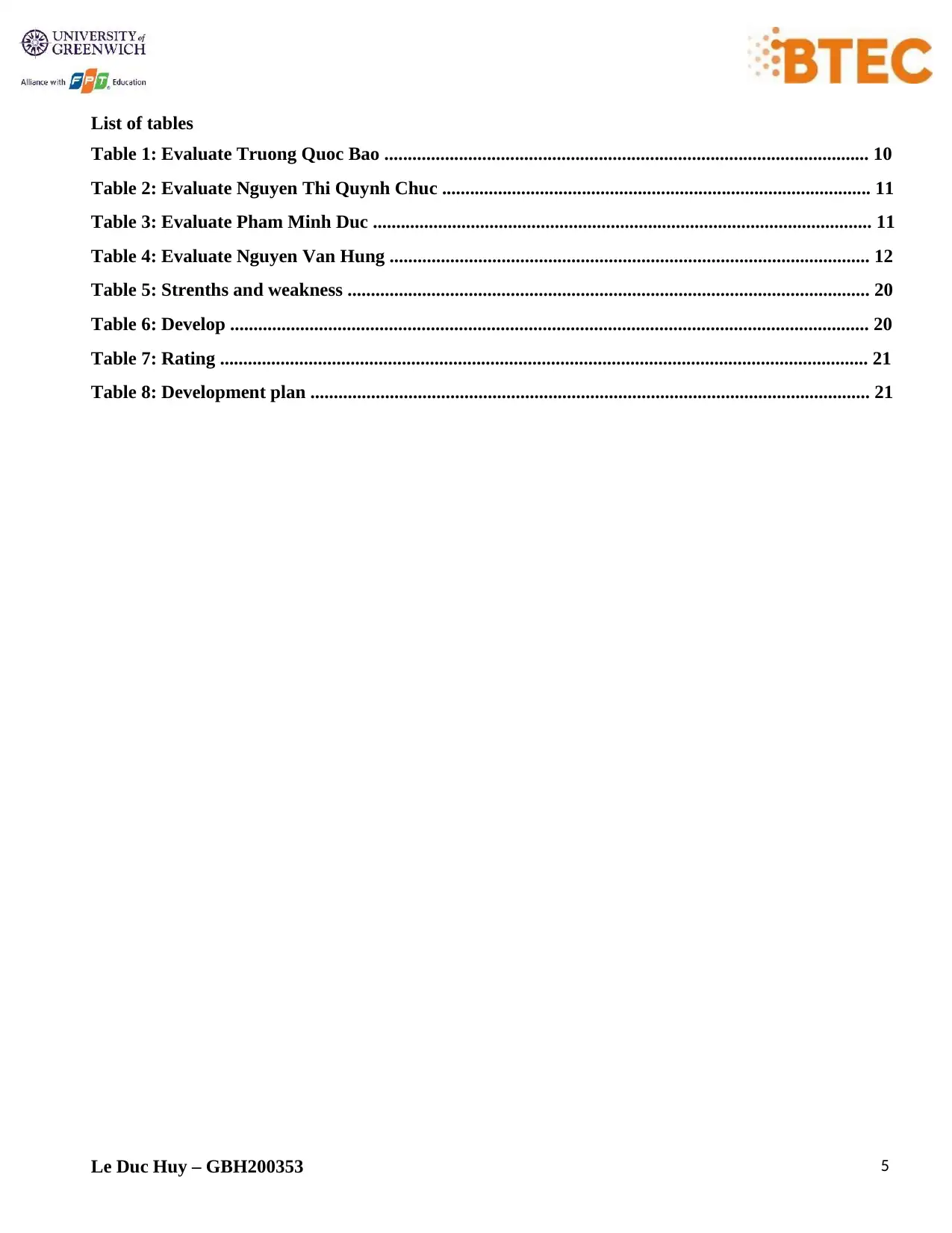
Le Duc Huy – GBH200353 5
List of tables
Table 1: Evaluate Truong Quoc Bao ........................................................................................................ 10
Table 2: Evaluate Nguyen Thi Quynh Chuc ............................................................................................ 11
Table 3: Evaluate Pham Minh Duc ........................................................................................................... 11
Table 4: Evaluate Nguyen Van Hung ....................................................................................................... 12
Table 5: Strenths and weakness ................................................................................................................ 20
Table 6: Develop ......................................................................................................................................... 20
Table 7: Rating ........................................................................................................................................... 21
Table 8: Development plan ........................................................................................................................ 21
List of tables
Table 1: Evaluate Truong Quoc Bao ........................................................................................................ 10
Table 2: Evaluate Nguyen Thi Quynh Chuc ............................................................................................ 11
Table 3: Evaluate Pham Minh Duc ........................................................................................................... 11
Table 4: Evaluate Nguyen Van Hung ....................................................................................................... 12
Table 5: Strenths and weakness ................................................................................................................ 20
Table 6: Develop ......................................................................................................................................... 20
Table 7: Rating ........................................................................................................................................... 21
Table 8: Development plan ........................................................................................................................ 21
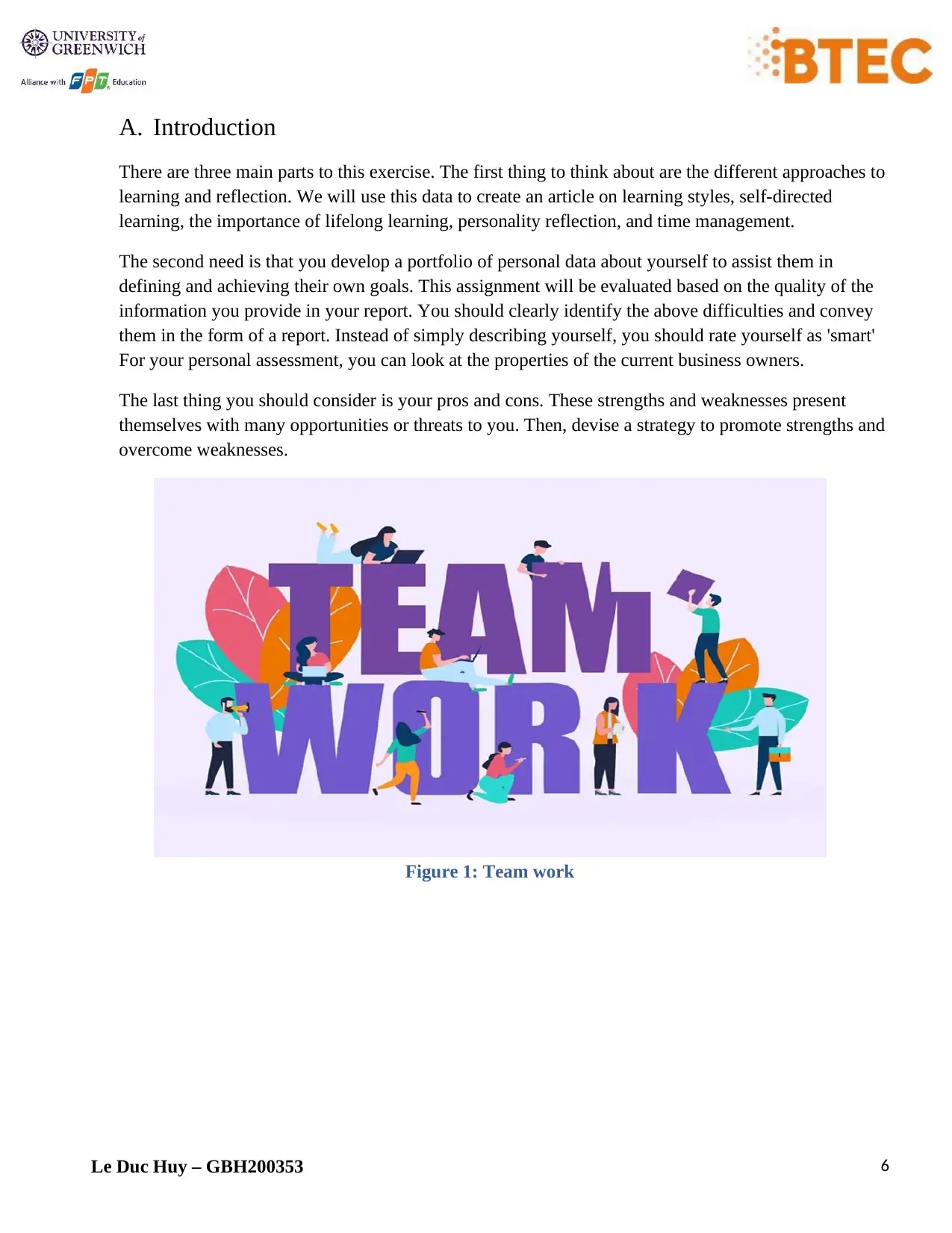
Le Duc Huy – GBH200353 6
A. Introduction
There are three main parts to this exercise. The first thing to think about are the different approaches to
learning and reflection. We will use this data to create an article on learning styles, self-directed
learning, the importance of lifelong learning, personality reflection, and time management.
The second need is that you develop a portfolio of personal data about yourself to assist them in
defining and achieving their own goals. This assignment will be evaluated based on the quality of the
information you provide in your report. You should clearly identify the above difficulties and convey
them in the form of a report. Instead of simply describing yourself, you should rate yourself as 'smart'
For your personal assessment, you can look at the properties of the current business owners.
The last thing you should consider is your pros and cons. These strengths and weaknesses present
themselves with many opportunities or threats to you. Then, devise a strategy to promote strengths and
overcome weaknesses.
Figure 1: Team work
A. Introduction
There are three main parts to this exercise. The first thing to think about are the different approaches to
learning and reflection. We will use this data to create an article on learning styles, self-directed
learning, the importance of lifelong learning, personality reflection, and time management.
The second need is that you develop a portfolio of personal data about yourself to assist them in
defining and achieving their own goals. This assignment will be evaluated based on the quality of the
information you provide in your report. You should clearly identify the above difficulties and convey
them in the form of a report. Instead of simply describing yourself, you should rate yourself as 'smart'
For your personal assessment, you can look at the properties of the current business owners.
The last thing you should consider is your pros and cons. These strengths and weaknesses present
themselves with many opportunities or threats to you. Then, devise a strategy to promote strengths and
overcome weaknesses.
Figure 1: Team work
⊘ This is a preview!⊘
Do you want full access?
Subscribe today to unlock all pages.

Trusted by 1+ million students worldwide
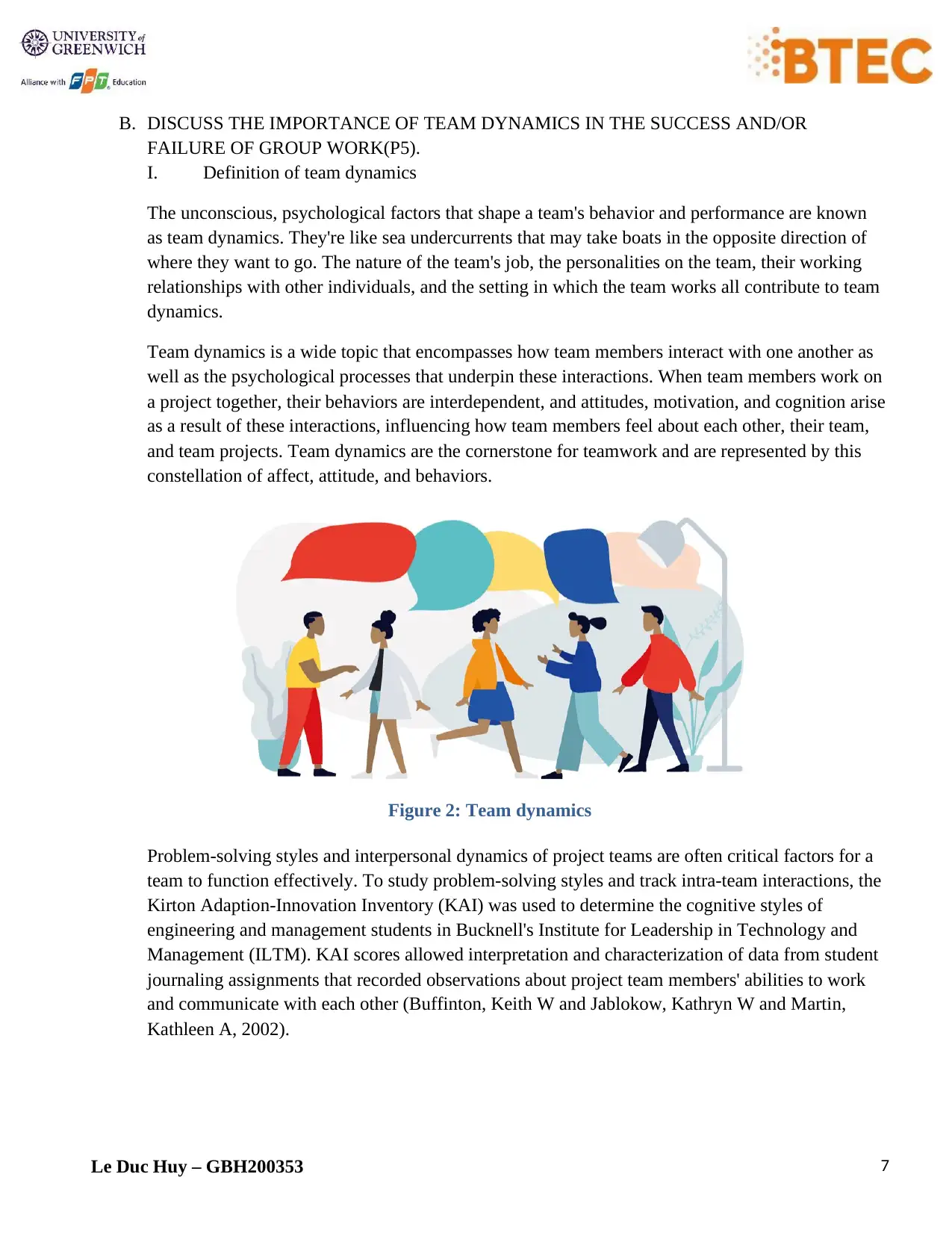
Le Duc Huy – GBH200353 7
B. DISCUSS THE IMPORTANCE OF TEAM DYNAMICS IN THE SUCCESS AND/OR
FAILURE OF GROUP WORK(P5).
I. Definition of team dynamics
The unconscious, psychological factors that shape a team's behavior and performance are known
as team dynamics. They're like sea undercurrents that may take boats in the opposite direction of
where they want to go. The nature of the team's job, the personalities on the team, their working
relationships with other individuals, and the setting in which the team works all contribute to team
dynamics.
Team dynamics is a wide topic that encompasses how team members interact with one another as
well as the psychological processes that underpin these interactions. When team members work on
a project together, their behaviors are interdependent, and attitudes, motivation, and cognition arise
as a result of these interactions, influencing how team members feel about each other, their team,
and team projects. Team dynamics are the cornerstone for teamwork and are represented by this
constellation of affect, attitude, and behaviors.
Figure 2: Team dynamics
Problem-solving styles and interpersonal dynamics of project teams are often critical factors for a
team to function effectively. To study problem-solving styles and track intra-team interactions, the
Kirton Adaption-Innovation Inventory (KAI) was used to determine the cognitive styles of
engineering and management students in Bucknell's Institute for Leadership in Technology and
Management (ILTM). KAI scores allowed interpretation and characterization of data from student
journaling assignments that recorded observations about project team members' abilities to work
and communicate with each other (Buffinton, Keith W and Jablokow, Kathryn W and Martin,
Kathleen A, 2002).
B. DISCUSS THE IMPORTANCE OF TEAM DYNAMICS IN THE SUCCESS AND/OR
FAILURE OF GROUP WORK(P5).
I. Definition of team dynamics
The unconscious, psychological factors that shape a team's behavior and performance are known
as team dynamics. They're like sea undercurrents that may take boats in the opposite direction of
where they want to go. The nature of the team's job, the personalities on the team, their working
relationships with other individuals, and the setting in which the team works all contribute to team
dynamics.
Team dynamics is a wide topic that encompasses how team members interact with one another as
well as the psychological processes that underpin these interactions. When team members work on
a project together, their behaviors are interdependent, and attitudes, motivation, and cognition arise
as a result of these interactions, influencing how team members feel about each other, their team,
and team projects. Team dynamics are the cornerstone for teamwork and are represented by this
constellation of affect, attitude, and behaviors.
Figure 2: Team dynamics
Problem-solving styles and interpersonal dynamics of project teams are often critical factors for a
team to function effectively. To study problem-solving styles and track intra-team interactions, the
Kirton Adaption-Innovation Inventory (KAI) was used to determine the cognitive styles of
engineering and management students in Bucknell's Institute for Leadership in Technology and
Management (ILTM). KAI scores allowed interpretation and characterization of data from student
journaling assignments that recorded observations about project team members' abilities to work
and communicate with each other (Buffinton, Keith W and Jablokow, Kathryn W and Martin,
Kathleen A, 2002).
Paraphrase This Document
Need a fresh take? Get an instant paraphrase of this document with our AI Paraphraser
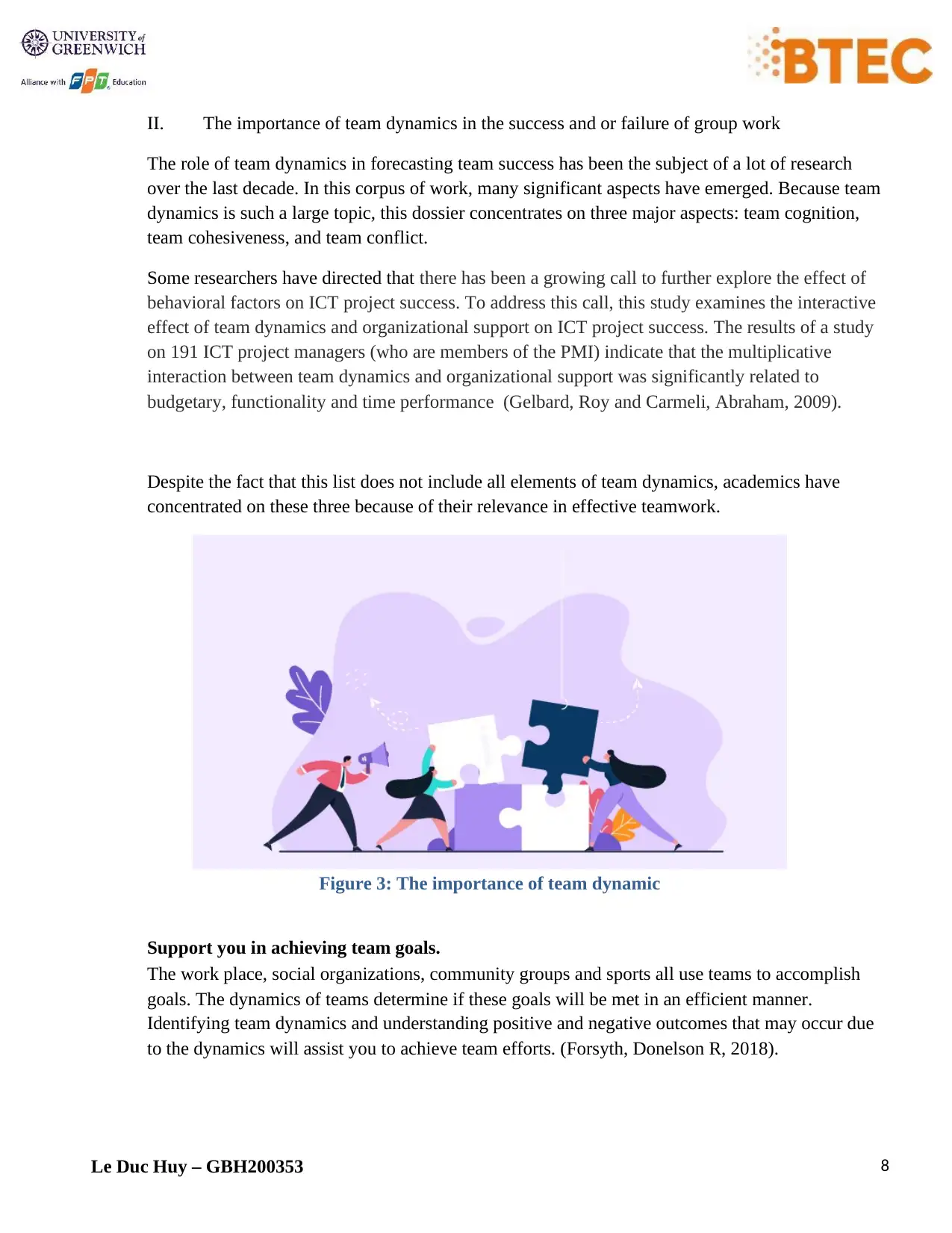
Le Duc Huy – GBH200353 8
II. The importance of team dynamics in the success and or failure of group work
The role of team dynamics in forecasting team success has been the subject of a lot of research
over the last decade. In this corpus of work, many significant aspects have emerged. Because team
dynamics is such a large topic, this dossier concentrates on three major aspects: team cognition,
team cohesiveness, and team conflict.
Some researchers have directed that there has been a growing call to further explore the effect of
behavioral factors on ICT project success. To address this call, this study examines the interactive
effect of team dynamics and organizational support on ICT project success. The results of a study
on 191 ICT project managers (who are members of the PMI) indicate that the multiplicative
interaction between team dynamics and organizational support was significantly related to
budgetary, functionality and time performance (Gelbard, Roy and Carmeli, Abraham, 2009).
Despite the fact that this list does not include all elements of team dynamics, academics have
concentrated on these three because of their relevance in effective teamwork.
Figure 3: The importance of team dynamic
Support you in achieving team goals.
The work place, social organizations, community groups and sports all use teams to accomplish
goals. The dynamics of teams determine if these goals will be met in an efficient manner.
Identifying team dynamics and understanding positive and negative outcomes that may occur due
to the dynamics will assist you to achieve team efforts. (Forsyth, Donelson R, 2018).
II. The importance of team dynamics in the success and or failure of group work
The role of team dynamics in forecasting team success has been the subject of a lot of research
over the last decade. In this corpus of work, many significant aspects have emerged. Because team
dynamics is such a large topic, this dossier concentrates on three major aspects: team cognition,
team cohesiveness, and team conflict.
Some researchers have directed that there has been a growing call to further explore the effect of
behavioral factors on ICT project success. To address this call, this study examines the interactive
effect of team dynamics and organizational support on ICT project success. The results of a study
on 191 ICT project managers (who are members of the PMI) indicate that the multiplicative
interaction between team dynamics and organizational support was significantly related to
budgetary, functionality and time performance (Gelbard, Roy and Carmeli, Abraham, 2009).
Despite the fact that this list does not include all elements of team dynamics, academics have
concentrated on these three because of their relevance in effective teamwork.
Figure 3: The importance of team dynamic
Support you in achieving team goals.
The work place, social organizations, community groups and sports all use teams to accomplish
goals. The dynamics of teams determine if these goals will be met in an efficient manner.
Identifying team dynamics and understanding positive and negative outcomes that may occur due
to the dynamics will assist you to achieve team efforts. (Forsyth, Donelson R, 2018).
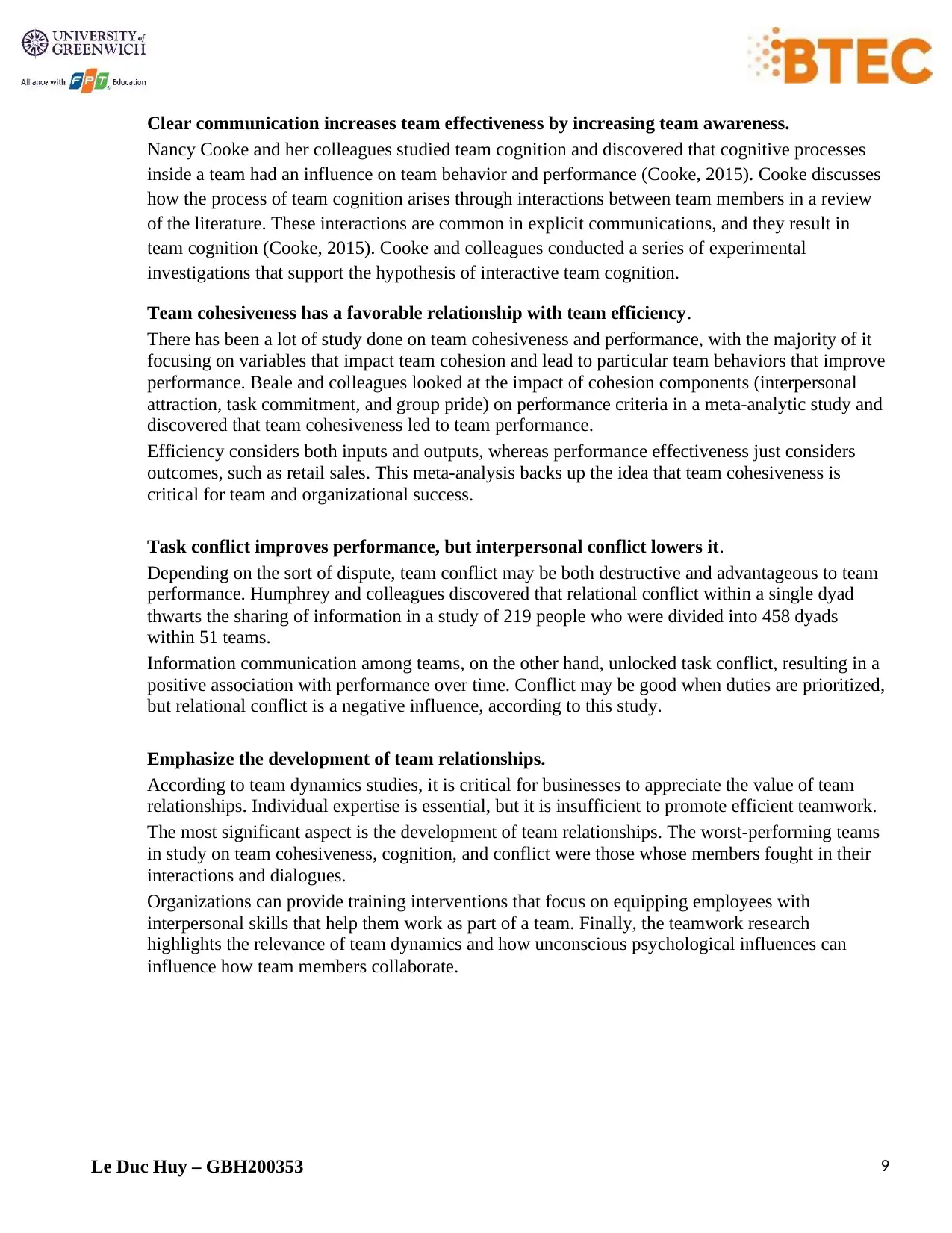
Le Duc Huy – GBH200353 9
Clear communication increases team effectiveness by increasing team awareness.
Nancy Cooke and her colleagues studied team cognition and discovered that cognitive processes
inside a team had an influence on team behavior and performance (Cooke, 2015). Cooke discusses
how the process of team cognition arises through interactions between team members in a review
of the literature. These interactions are common in explicit communications, and they result in
team cognition (Cooke, 2015). Cooke and colleagues conducted a series of experimental
investigations that support the hypothesis of interactive team cognition.
Team cohesiveness has a favorable relationship with team efficiency.
There has been a lot of study done on team cohesiveness and performance, with the majority of it
focusing on variables that impact team cohesion and lead to particular team behaviors that improve
performance. Beale and colleagues looked at the impact of cohesion components (interpersonal
attraction, task commitment, and group pride) on performance criteria in a meta-analytic study and
discovered that team cohesiveness led to team performance.
Efficiency considers both inputs and outputs, whereas performance effectiveness just considers
outcomes, such as retail sales. This meta-analysis backs up the idea that team cohesiveness is
critical for team and organizational success.
Task conflict improves performance, but interpersonal conflict lowers it.
Depending on the sort of dispute, team conflict may be both destructive and advantageous to team
performance. Humphrey and colleagues discovered that relational conflict within a single dyad
thwarts the sharing of information in a study of 219 people who were divided into 458 dyads
within 51 teams.
Information communication among teams, on the other hand, unlocked task conflict, resulting in a
positive association with performance over time. Conflict may be good when duties are prioritized,
but relational conflict is a negative influence, according to this study.
Emphasize the development of team relationships.
According to team dynamics studies, it is critical for businesses to appreciate the value of team
relationships. Individual expertise is essential, but it is insufficient to promote efficient teamwork.
The most significant aspect is the development of team relationships. The worst-performing teams
in study on team cohesiveness, cognition, and conflict were those whose members fought in their
interactions and dialogues.
Organizations can provide training interventions that focus on equipping employees with
interpersonal skills that help them work as part of a team. Finally, the teamwork research
highlights the relevance of team dynamics and how unconscious psychological influences can
influence how team members collaborate.
Clear communication increases team effectiveness by increasing team awareness.
Nancy Cooke and her colleagues studied team cognition and discovered that cognitive processes
inside a team had an influence on team behavior and performance (Cooke, 2015). Cooke discusses
how the process of team cognition arises through interactions between team members in a review
of the literature. These interactions are common in explicit communications, and they result in
team cognition (Cooke, 2015). Cooke and colleagues conducted a series of experimental
investigations that support the hypothesis of interactive team cognition.
Team cohesiveness has a favorable relationship with team efficiency.
There has been a lot of study done on team cohesiveness and performance, with the majority of it
focusing on variables that impact team cohesion and lead to particular team behaviors that improve
performance. Beale and colleagues looked at the impact of cohesion components (interpersonal
attraction, task commitment, and group pride) on performance criteria in a meta-analytic study and
discovered that team cohesiveness led to team performance.
Efficiency considers both inputs and outputs, whereas performance effectiveness just considers
outcomes, such as retail sales. This meta-analysis backs up the idea that team cohesiveness is
critical for team and organizational success.
Task conflict improves performance, but interpersonal conflict lowers it.
Depending on the sort of dispute, team conflict may be both destructive and advantageous to team
performance. Humphrey and colleagues discovered that relational conflict within a single dyad
thwarts the sharing of information in a study of 219 people who were divided into 458 dyads
within 51 teams.
Information communication among teams, on the other hand, unlocked task conflict, resulting in a
positive association with performance over time. Conflict may be good when duties are prioritized,
but relational conflict is a negative influence, according to this study.
Emphasize the development of team relationships.
According to team dynamics studies, it is critical for businesses to appreciate the value of team
relationships. Individual expertise is essential, but it is insufficient to promote efficient teamwork.
The most significant aspect is the development of team relationships. The worst-performing teams
in study on team cohesiveness, cognition, and conflict were those whose members fought in their
interactions and dialogues.
Organizations can provide training interventions that focus on equipping employees with
interpersonal skills that help them work as part of a team. Finally, the teamwork research
highlights the relevance of team dynamics and how unconscious psychological influences can
influence how team members collaborate.
⊘ This is a preview!⊘
Do you want full access?
Subscribe today to unlock all pages.

Trusted by 1+ million students worldwide
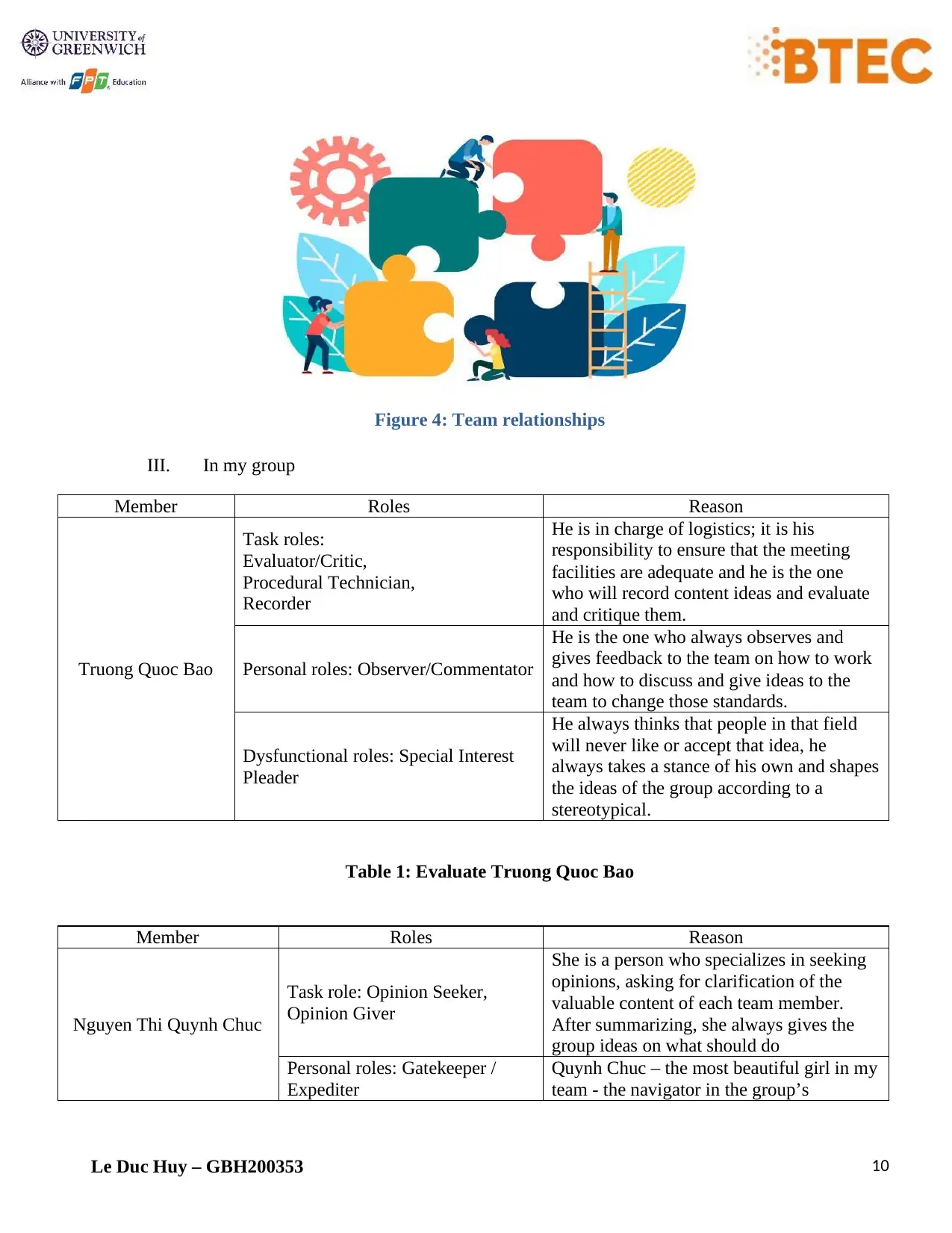
Le Duc Huy – GBH200353 10
Figure 4: Team relationships
III. In my group
Member Roles Reason
Truong Quoc Bao
Task roles:
Evaluator/Critic,
Procedural Technician,
Recorder
He is in charge of logistics; it is his
responsibility to ensure that the meeting
facilities are adequate and he is the one
who will record content ideas and evaluate
and critique them.
Personal roles: Observer/Commentator
He is the one who always observes and
gives feedback to the team on how to work
and how to discuss and give ideas to the
team to change those standards.
Dysfunctional roles: Special Interest
Pleader
He always thinks that people in that field
will never like or accept that idea, he
always takes a stance of his own and shapes
the ideas of the group according to a
stereotypical.
Table 1: Evaluate Truong Quoc Bao
Member Roles Reason
Nguyen Thi Quynh Chuc
Task role: Opinion Seeker,
Opinion Giver
She is a person who specializes in seeking
opinions, asking for clarification of the
valuable content of each team member.
After summarizing, she always gives the
group ideas on what should do
Personal roles: Gatekeeper /
Expediter
Quynh Chuc – the most beautiful girl in my
team - the navigator in the group’s
Figure 4: Team relationships
III. In my group
Member Roles Reason
Truong Quoc Bao
Task roles:
Evaluator/Critic,
Procedural Technician,
Recorder
He is in charge of logistics; it is his
responsibility to ensure that the meeting
facilities are adequate and he is the one
who will record content ideas and evaluate
and critique them.
Personal roles: Observer/Commentator
He is the one who always observes and
gives feedback to the team on how to work
and how to discuss and give ideas to the
team to change those standards.
Dysfunctional roles: Special Interest
Pleader
He always thinks that people in that field
will never like or accept that idea, he
always takes a stance of his own and shapes
the ideas of the group according to a
stereotypical.
Table 1: Evaluate Truong Quoc Bao
Member Roles Reason
Nguyen Thi Quynh Chuc
Task role: Opinion Seeker,
Opinion Giver
She is a person who specializes in seeking
opinions, asking for clarification of the
valuable content of each team member.
After summarizing, she always gives the
group ideas on what should do
Personal roles: Gatekeeper /
Expediter
Quynh Chuc – the most beautiful girl in my
team - the navigator in the group’s
Paraphrase This Document
Need a fresh take? Get an instant paraphrase of this document with our AI Paraphraser
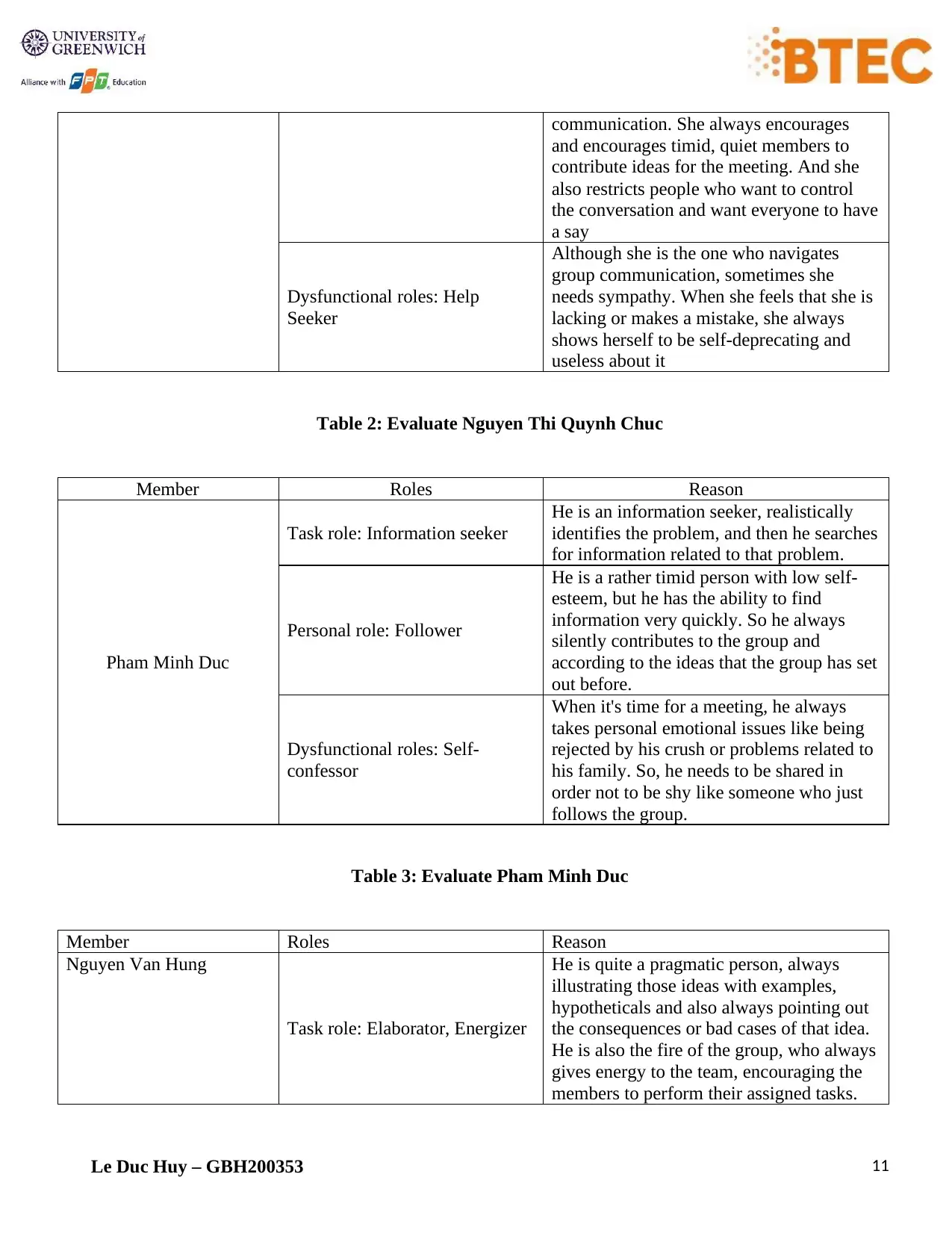
Le Duc Huy – GBH200353 11
communication. She always encourages
and encourages timid, quiet members to
contribute ideas for the meeting. And she
also restricts people who want to control
the conversation and want everyone to have
a say
Dysfunctional roles: Help
Seeker
Although she is the one who navigates
group communication, sometimes she
needs sympathy. When she feels that she is
lacking or makes a mistake, she always
shows herself to be self-deprecating and
useless about it
Table 2: Evaluate Nguyen Thi Quynh Chuc
Member Roles Reason
Pham Minh Duc
Task role: Information seeker
He is an information seeker, realistically
identifies the problem, and then he searches
for information related to that problem.
Personal role: Follower
He is a rather timid person with low self-
esteem, but he has the ability to find
information very quickly. So he always
silently contributes to the group and
according to the ideas that the group has set
out before.
Dysfunctional roles: Self-
confessor
When it's time for a meeting, he always
takes personal emotional issues like being
rejected by his crush or problems related to
his family. So, he needs to be shared in
order not to be shy like someone who just
follows the group.
Table 3: Evaluate Pham Minh Duc
Member Roles Reason
Nguyen Van Hung
Task role: Elaborator, Energizer
He is quite a pragmatic person, always
illustrating those ideas with examples,
hypotheticals and also always pointing out
the consequences or bad cases of that idea.
He is also the fire of the group, who always
gives energy to the team, encouraging the
members to perform their assigned tasks.
communication. She always encourages
and encourages timid, quiet members to
contribute ideas for the meeting. And she
also restricts people who want to control
the conversation and want everyone to have
a say
Dysfunctional roles: Help
Seeker
Although she is the one who navigates
group communication, sometimes she
needs sympathy. When she feels that she is
lacking or makes a mistake, she always
shows herself to be self-deprecating and
useless about it
Table 2: Evaluate Nguyen Thi Quynh Chuc
Member Roles Reason
Pham Minh Duc
Task role: Information seeker
He is an information seeker, realistically
identifies the problem, and then he searches
for information related to that problem.
Personal role: Follower
He is a rather timid person with low self-
esteem, but he has the ability to find
information very quickly. So he always
silently contributes to the group and
according to the ideas that the group has set
out before.
Dysfunctional roles: Self-
confessor
When it's time for a meeting, he always
takes personal emotional issues like being
rejected by his crush or problems related to
his family. So, he needs to be shared in
order not to be shy like someone who just
follows the group.
Table 3: Evaluate Pham Minh Duc
Member Roles Reason
Nguyen Van Hung
Task role: Elaborator, Energizer
He is quite a pragmatic person, always
illustrating those ideas with examples,
hypotheticals and also always pointing out
the consequences or bad cases of that idea.
He is also the fire of the group, who always
gives energy to the team, encouraging the
members to perform their assigned tasks.
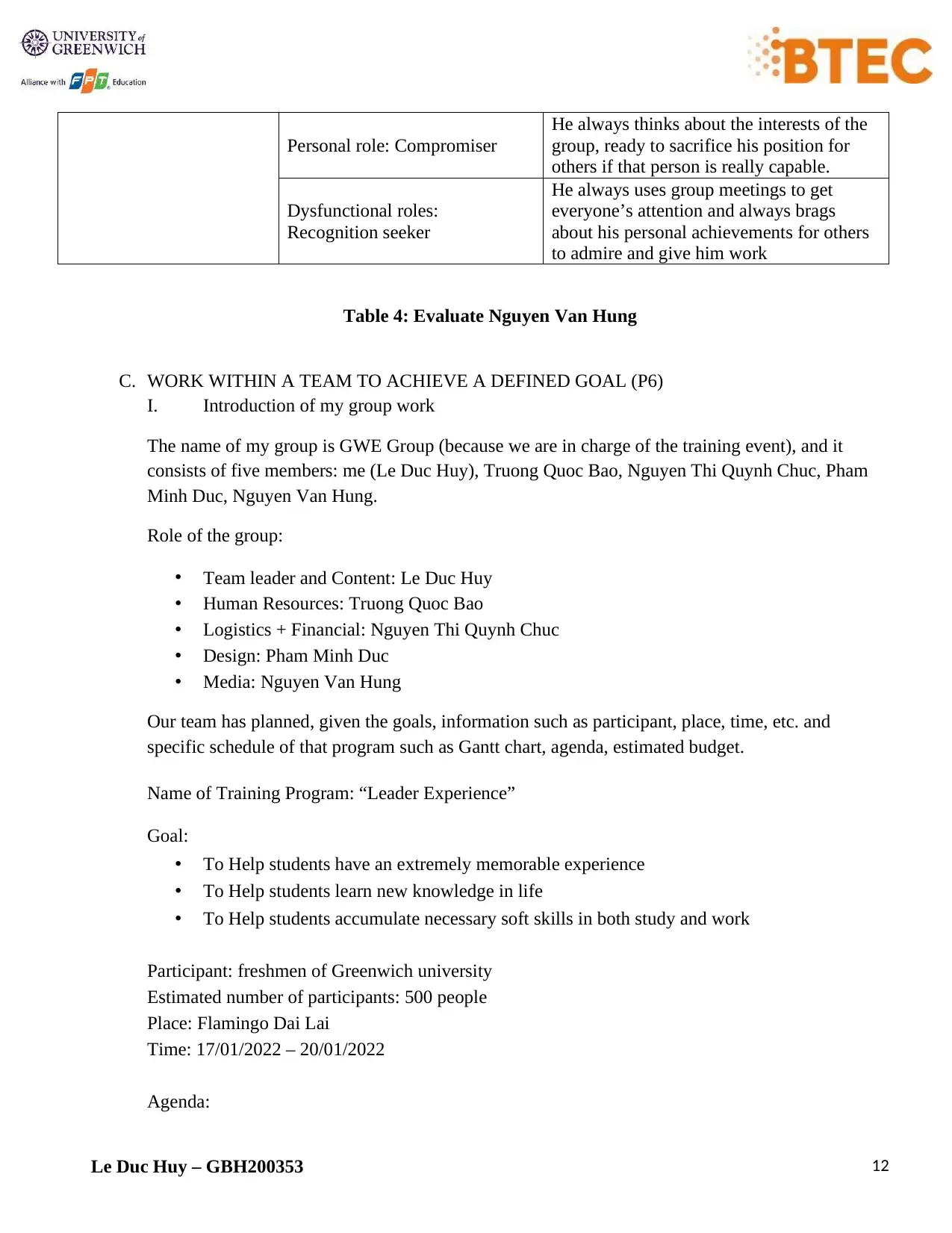
Le Duc Huy – GBH200353 12
Personal role: Compromiser
He always thinks about the interests of the
group, ready to sacrifice his position for
others if that person is really capable.
Dysfunctional roles:
Recognition seeker
He always uses group meetings to get
everyone’s attention and always brags
about his personal achievements for others
to admire and give him work
Table 4: Evaluate Nguyen Van Hung
C. WORK WITHIN A TEAM TO ACHIEVE A DEFINED GOAL (P6)
I. Introduction of my group work
The name of my group is GWE Group (because we are in charge of the training event), and it
consists of five members: me (Le Duc Huy), Truong Quoc Bao, Nguyen Thi Quynh Chuc, Pham
Minh Duc, Nguyen Van Hung.
Role of the group:
• Team leader and Content: Le Duc Huy
• Human Resources: Truong Quoc Bao
• Logistics + Financial: Nguyen Thi Quynh Chuc
• Design: Pham Minh Duc
• Media: Nguyen Van Hung
Our team has planned, given the goals, information such as participant, place, time, etc. and
specific schedule of that program such as Gantt chart, agenda, estimated budget.
Name of Training Program: “Leader Experience”
Goal:
• To Help students have an extremely memorable experience
• To Help students learn new knowledge in life
• To Help students accumulate necessary soft skills in both study and work
Participant: freshmen of Greenwich university
Estimated number of participants: 500 people
Place: Flamingo Dai Lai
Time: 17/01/2022 – 20/01/2022
Agenda:
Personal role: Compromiser
He always thinks about the interests of the
group, ready to sacrifice his position for
others if that person is really capable.
Dysfunctional roles:
Recognition seeker
He always uses group meetings to get
everyone’s attention and always brags
about his personal achievements for others
to admire and give him work
Table 4: Evaluate Nguyen Van Hung
C. WORK WITHIN A TEAM TO ACHIEVE A DEFINED GOAL (P6)
I. Introduction of my group work
The name of my group is GWE Group (because we are in charge of the training event), and it
consists of five members: me (Le Duc Huy), Truong Quoc Bao, Nguyen Thi Quynh Chuc, Pham
Minh Duc, Nguyen Van Hung.
Role of the group:
• Team leader and Content: Le Duc Huy
• Human Resources: Truong Quoc Bao
• Logistics + Financial: Nguyen Thi Quynh Chuc
• Design: Pham Minh Duc
• Media: Nguyen Van Hung
Our team has planned, given the goals, information such as participant, place, time, etc. and
specific schedule of that program such as Gantt chart, agenda, estimated budget.
Name of Training Program: “Leader Experience”
Goal:
• To Help students have an extremely memorable experience
• To Help students learn new knowledge in life
• To Help students accumulate necessary soft skills in both study and work
Participant: freshmen of Greenwich university
Estimated number of participants: 500 people
Place: Flamingo Dai Lai
Time: 17/01/2022 – 20/01/2022
Agenda:
⊘ This is a preview!⊘
Do you want full access?
Subscribe today to unlock all pages.

Trusted by 1+ million students worldwide
1 out of 23
Related Documents
Your All-in-One AI-Powered Toolkit for Academic Success.
+13062052269
info@desklib.com
Available 24*7 on WhatsApp / Email
![[object Object]](/_next/static/media/star-bottom.7253800d.svg)
Unlock your academic potential
Copyright © 2020–2025 A2Z Services. All Rights Reserved. Developed and managed by ZUCOL.





